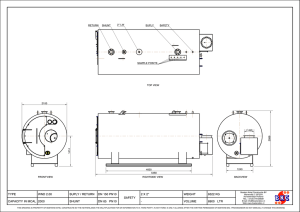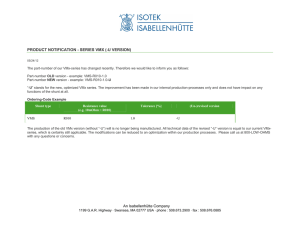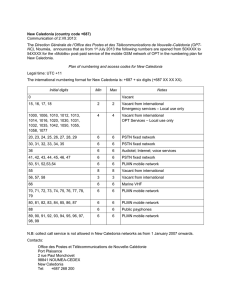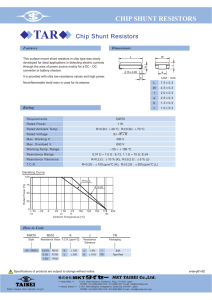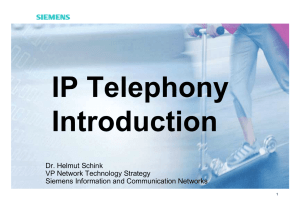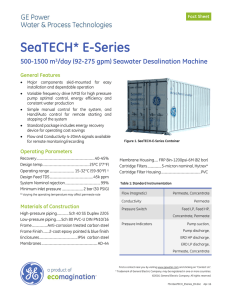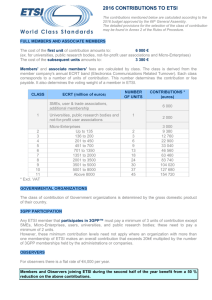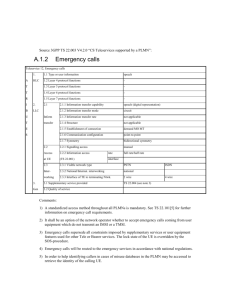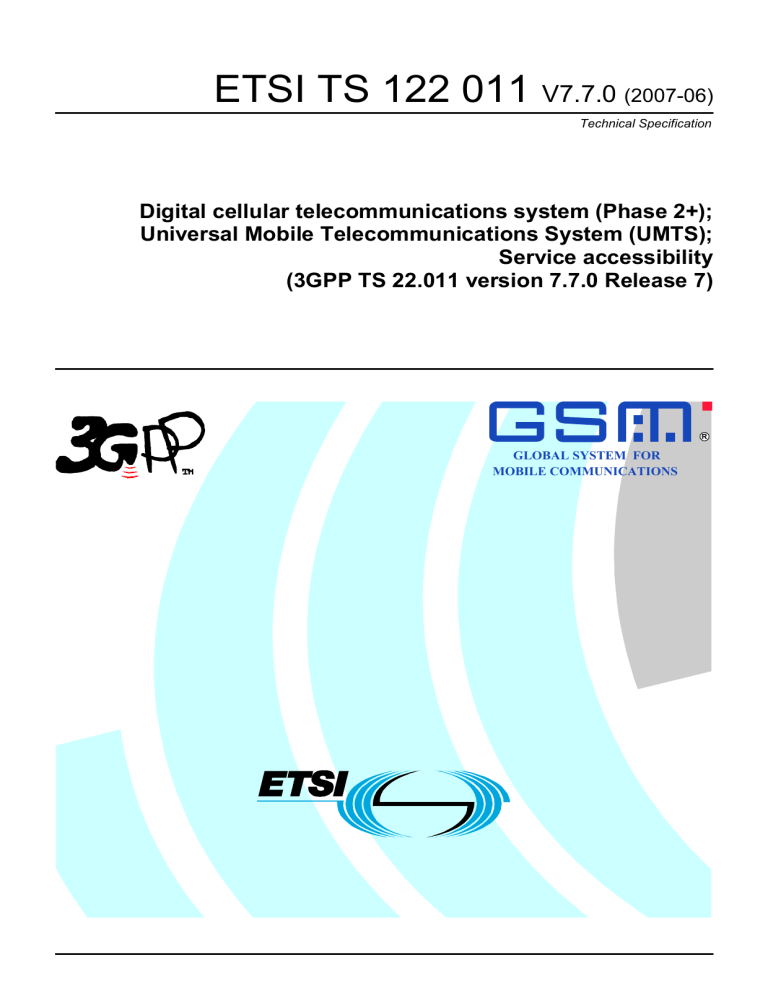
ETSI TS 122 011 V7.7.0 (2007-06) Technical Specification Digital cellular telecommunications system (Phase 2+); Universal Mobile Telecommunications System (UMTS); Service accessibility (3GPP TS 22.011 version 7.7.0 Release 7) R GLOBAL SYSTEM FOR MOBILE COMMUNICATIONS 3GPP TS 22.011 version 7.7.0 Release 7 1 ETSI TS 122 011 V7.7.0 (2007-06) Reference RTS/TSGS-0122011v770 Keywords GSM, UMTS ETSI 650 Route des Lucioles F-06921 Sophia Antipolis Cedex - FRANCE Tel.: +33 4 92 94 42 00 Fax: +33 4 93 65 47 16 Siret N° 348 623 562 00017 - NAF 742 C Association à but non lucratif enregistrée à la Sous-Préfecture de Grasse (06) N° 7803/88 Important notice Individual copies of the present document can be downloaded from: http://www.etsi.org The present document may be made available in more than one electronic version or in print. In any case of existing or perceived difference in contents between such versions, the reference version is the Portable Document Format (PDF). In case of dispute, the reference shall be the printing on ETSI printers of the PDF version kept on a specific network drive within ETSI Secretariat. Users of the present document should be aware that the document may be subject to revision or change of status. Information on the current status of this and other ETSI documents is available at http://portal.etsi.org/tb/status/status.asp If you find errors in the present document, please send your comment to one of the following services: http://portal.etsi.org/chaircor/ETSI_support.asp Copyright Notification No part may be reproduced except as authorized by written permission. The copyright and the foregoing restriction extend to reproduction in all media. © European Telecommunications Standards Institute 2007. All rights reserved. TM TM TM DECT , PLUGTESTS and UMTS are Trade Marks of ETSI registered for the benefit of its Members. TM TIPHON and the TIPHON logo are Trade Marks currently being registered by ETSI for the benefit of its Members. TM 3GPP is a Trade Mark of ETSI registered for the benefit of its Members and of the 3GPP Organizational Partners. ETSI 3GPP TS 22.011 version 7.7.0 Release 7 2 ETSI TS 122 011 V7.7.0 (2007-06) Intellectual Property Rights IPRs essential or potentially essential to the present document may have been declared to ETSI. The information pertaining to these essential IPRs, if any, is publicly available for ETSI members and non-members, and can be found in ETSI SR 000 314: "Intellectual Property Rights (IPRs); Essential, or potentially Essential, IPRs notified to ETSI in respect of ETSI standards", which is available from the ETSI Secretariat. Latest updates are available on the ETSI Web server (http://webapp.etsi.org/IPR/home.asp). Pursuant to the ETSI IPR Policy, no investigation, including IPR searches, has been carried out by ETSI. No guarantee can be given as to the existence of other IPRs not referenced in ETSI SR 000 314 (or the updates on the ETSI Web server) which are, or may be, or may become, essential to the present document. Foreword This Technical Specification (TS) has been produced by ETSI 3rd Generation Partnership Project (3GPP). The present document may refer to technical specifications or reports using their 3GPP identities, UMTS identities or GSM identities. These should be interpreted as being references to the corresponding ETSI deliverables. The cross reference between GSM, UMTS, 3GPP and ETSI identities can be found under http://webapp.etsi.org/key/queryform.asp. ETSI 3GPP TS 22.011 version 7.7.0 Release 7 3 ETSI TS 122 011 V7.7.0 (2007-06) Contents Intellectual Property Rights ................................................................................................................................2 Foreword.............................................................................................................................................................2 Foreword.............................................................................................................................................................4 1 1.1 1.2 2 2.1 2.2 2.3 2.4 3 Scope ........................................................................................................................................................5 References ..........................................................................................................................................................5 Definitions and abbreviations.............................................................................................................................5 Roaming ...................................................................................................................................................6 General requirements .........................................................................................................................................6 International roaming .........................................................................................................................................6 National roaming................................................................................................................................................7 Roaming in shared networks ..............................................................................................................................7 Provisions for providing continuity of service .........................................................................................7 3.1 Location registration...........................................................................................................................................7 3.2 Network selection...............................................................................................................................................7 3.2.1 General..........................................................................................................................................................7 3.2.2 Procedures.....................................................................................................................................................8 3.2.2.1 General ....................................................................................................................................................8 3.2.2.2 At switch-on or recovery from lack of coverage.....................................................................................9 3.2.2.3 User reselection.....................................................................................................................................11 3.2.2.4 Mobile Station reactions to indications of service restriction from the network...................................11 3.2.2.4.1 "Permanent" PLMN restriction........................................................................................................11 3.2.2.4.2 "Partial" and "temporary" PLMN restrictions .................................................................................11 3.2.2.4.3 PLMN restrictions for PS services ..................................................................................................12 3.2.2.5 Periodic network selection attempts......................................................................................................12 3.2.2.6 Investigation PLMN Scan .....................................................................................................................12 3.2.2.7 Void.......................................................................................................................................................12 3.2.2.8 Steering Of Roaming.............................................................................................................................13 3.2.3 Network selection for Multi-mode terminals with 3GPP Capability ..........................................................13 4 4.1 4.2 4.3 4.4 4.5 5 5.1 5.2 5.2.1 5.2.2 5.2.3 5.3 5.4 5.5 6 6.1 6.2 6.3 7 Access control ........................................................................................................................................14 Purpose.............................................................................................................................................................14 Allocation .........................................................................................................................................................14 Operation..........................................................................................................................................................14 Emergency Calls ..............................................................................................................................................14 Control of UE Capabilities ...............................................................................................................................15 Support of Localised Service Area (SoLSA) .........................................................................................15 Network selection.............................................................................................................................................15 The Idle-mode operation ..................................................................................................................................16 Subscriber moving from a normal environment to his localised service area.............................................16 Subscriber moving away from his localised service area to a normal environment. ..................................16 Subscriber staying in his localised service area ..........................................................................................16 LSA only access ...............................................................................................................................................16 Exclusive access ...............................................................................................................................................16 Preferential access ............................................................................................................................................16 Support of 3GPP - WLAN Interworking ...............................................................................................16 Void..................................................................................................................................................................17 Void..................................................................................................................................................................17 Void..................................................................................................................................................................17 Administrative restriction of subscribers" access...................................................................................17 Annex A (informative): Change history ...............................................................................................18 History ..............................................................................................................................................................20 ETSI 3GPP TS 22.011 version 7.7.0 Release 7 4 ETSI TS 122 011 V7.7.0 (2007-06) Foreword This Technical Specification has been produced by the 3GPP. The contents of the present document are subject to continuing work within the TSG and may change following formal TSG approval. Should the TSG modify the contents of the present document, it will be re-released by the TSG with an identifying change of release date and an increase in version number as follows: Version x.y.z where: x the first digit: 1 presented to TSG for information; 2 presented to TSG for approval; 3 or greater indicates TSG approved document under change control. y the second digit is incremented for all changes of substance, i.e. technical enhancements, corrections, updates, etc. z the third digit is incremented when editorial only changes have been incorporated in the document. ETSI 3GPP TS 22.011 version 7.7.0 Release 7 1 5 ETSI TS 122 011 V7.7.0 (2007-06) Scope The purpose of this TS is to describe the service access procedures as presented to the user. Definitions and procedures are provided in this TS for international roaming, national roaming and regionally provided service. These are mandatory in relation to the technical realization of the Mobile Station (UE). 1.1 References The following documents contain provisions which, through reference in this text, constitute provisions of the present document. • References are either specific (identified by date of publication, edition number, version number, etc.) or non-specific. • For a specific reference, subsequent revisions do not apply. • For a non-specific reference, the latest version applies. In the case of a reference to a 3GPP document (including a GSM document), a non-specific reference implicitly refers to the latest version of that document in the same Release as the present document. [1] Void [2] 3GPP TR 21.905: "Vocabulary for 3GPP Specifications". [3] 3GPP TS 23.122: "Non Access Stratum functions related to Mobile Station (MS) in idle mode". [4] ITU-T Recommendation Q.1001: "General aspects of Public Land Mobile Networks". [5] 3GPP TS 22.043: " Support of Localised Service Area (SoLSA). Stage 1". [6] 3GPP TS 22.234: "Requirements on 3GPP system to wireless local area network (WLAN) interworking". [7] 3GPP TS 22.101: "Service aspects; Service principles". 1.2 Definitions and abbreviations In addition to those below, abbreviations used in this 3GPP TS are listed in 3GPP TR 21.905 [2]. PLMN A Public Land Mobile Network (PLMN) is a network established and operated by an Administration or RPOA for the specific purpose of providing land mobile communication services to the public. It provides communication possibilities for mobile users. For communications between mobile and fixed users, interworking with a fixed network is necessary. A PLMN may provide service in one, or a combination, of frequency bands. As a rule, a PLMN is limited by the borders of a country. Depending on national regulations there may be more than one PLMN per country. A relationship exists between each subscriber and his home PLMN (HPLMN). If communications are handled over another PLMN, this PLMN is referred to as the visited PLMN (VPLMN). PLMN Area The PLMN area is the geographical area in which a PLMN provides communication services according to the specifications to mobile users. In the PLMN area, the mobile user can set up calls to a user of a terminating network. The terminating network may be a fixed network, the same PLMN, another PLMN or other types of PLMN. ETSI 3GPP TS 22.011 version 7.7.0 Release 7 6 ETSI TS 122 011 V7.7.0 (2007-06) Terminating network users can also set up calls to the PLMN. The PLMN area is allocated to a PLMN. It is determined by the service and network provider in accordance with any provisions laid down under national law. In general the PLMN area is restricted to one country. It can also be determined differently, depending on the different telecommunication services, or type of UE. If there are several PLMNs in one country, their PLMN areas may overlap. In border areas, the PLMN areas of different countries may overlap. Administrations will have to take precautions to ensure that cross border coverage is minimized in adjacent countries unless otherwise agreed. NOTE 1: ITU-T Recommendation Q.1001 [4] does not contain a definition of the PLMN area. System Area The System Area is defined as the group of PLMN areas accessible by UEs. Interworking of several PLMNs and interworking between PLMNs and fixed network(s) permit public land mobile communication services at international level. NOTE 2: The System Area according to [4] Recommendation Q.1001 corresponds to the System Area. Service Area The Service Area is defined in the same way as the Service Area according to ITU-T Recommendation Q.1001 [4]. In contrast to the PLMN area it is not based on the coverage of a PLMN. Instead it is based on the area in which a fixed network user can call a mobile user without knowing his location. The Service Area can therefore change when the signalling system is being extended, for example. Regionally Provided Service Regionally Provided Service is defined as a service entitlement to only certain geographical part(s) of a PLMN, as controlled by the network operator. Localised Service Area (LSA) The localised service area concept shall give the operator a basis to offer subscribers different services (e.g. tariffs or access rights) depending on the location of the subscriber. A LSA consists of a cell or a number of cells within a PLMN. (3GPP TS 22.043 [5]). 2 Roaming 2.1 General requirements A UE with a valid IMSI may roam and access service in the area authorized by the entitlement of the subscription. If a communication has been established, the UE will in principle not suffer an interruption within the PLMN area (provided the entitlement of the subscription allows it). Exceptions are possible if no network resources or radio coverage are available locally. However, if the UE leaves the PLMN area, an established communication may terminate. If the user then wants to continue, another network providing service has to be selected and a new communication has to be established (see clause 3). 2.2 International roaming International roaming is a service whereby an UE of a given PLMN is able to obtain service from a PLMN of another country. The availability of International Roaming is subject to inter-PLMN agreements. ETSI 3GPP TS 22.011 version 7.7.0 Release 7 2.3 7 ETSI TS 122 011 V7.7.0 (2007-06) National roaming National Roaming is a service whereby an UE of a given PLMN is able to obtain service from another PLMN of the same country, anywhere, or on a regional basis. The availability of National Roaming depends on the home PLMN of the requesting UE and the visited PLMN; it does not depend on subscription arrangements. 2.4 Roaming in shared networks Mechanisms shall be specified to enable flexible allocation of visiting roamers among core network operators that have roaming agreements with the same roaming partners. The core network operators shall be able to pre-define their relative share of visiting roamers and distribute the visiting roamers that apply automatic network selection to different core networks connected to the radio access network accordingly. When network sharing exists between different operators and a user roams into the shared network it shall be possible for that user to register with a core network operator (among the network sharing partners) that the user"s home operator has a roaming agreement with, even if the operator is not operating a radio access network in that area. The selection of a core network operator among those connected to the shared radio access network can either be manual (i.e. performed by the user after receiving a list of available core network operators) or automatic (i.e. performed by the UE according to user and operator preferred settings). For further information see subclause 3.2. 3 Provisions for providing continuity of service 3.1 Location registration PLMNs shall provide a location registration function with the main purpose of providing continuity of service to UEs over the whole system area. The location registration function shall be such as to allow: - Fixed subscribers to call a UE by only using the directory number of the UE irrespective of where the UE is located in the system area at the time of the call. - UEs to access the system irrespective of the location of the UE. - UEs to identify when a change in location area has taken place in order to initiate automatic location updating procedures. 3.2 Network selection 3.2.1 General The UE shall support both manual and automatic network selection mechanisms (modes). The UE shall select the last mode used, as the default mode, at every switch-on. As an optional feature of the ME, the user shall be able to set a preference in the ME for the mode that shall be used at switch on. If set then the ME shall select this preference rather than the default mode. NOTE: By defaulting to the last mode used, e.g. manual network selection, the undesired automatic selection of an adjacent PLMN instead of the desired HPLMN in border areas, can be avoided at switch-on. The user shall be given the opportunity to change mode at any time. Except as defined below, the MMI shall be at the discretion of the UE manufacturer. The UE shall contain display functions by which Available PLMNs and the Selected PLMN can be indicated. ETSI 3GPP TS 22.011 version 7.7.0 Release 7 8 ETSI TS 122 011 V7.7.0 (2007-06) In order not to confuse the user, the same definitions of PLMN names shall be applied consistently both in registered mode and in the list presented to the user when in manual mode. In shared networks a radio access network can be part of more than one PLMN. This shall be transparent to the user, i.e. the UE shall be able to indicate those PLMNs to the user, and the UE shall support network selection among those PLMNs, as in non-shared networks. 3.2.2 Procedures 3.2.2.1 General In the following procedures the UE selects and attempts registration on PLMNs. In this TS, the term "PLMN Selection" defines an UE based procedure, whereby candidate PLMNs are chosen, one at a time, for attempted registration. A User Controlled PLMN Selector data field exists on the USIM to allow the user to indicate a preference for network selection. It shall be possible for the user to update the User Controlled PLMN Selector data field, but it shall not be possible to update this data field over the radio interface, e.g. using SIM Application Toolkit. It shall be possible to have an Operator Controlled PLMN Selector list and a User Controlled PLMN Selector list stored on the SIM/USIM card. Both PLMN Selector lists may contain a list of preferred PLMNs in priority order. It shall be possible to have an associated Access Technology identifier e.g., UTRAN, or GERAN associated with each entry in the PLMN Selector lists. The UE shall utilise all the information stored in the USIM related to network selection, e.g. HPLMN, Operator controlled PLMN Selector list, User Controlled PLMN Selector list, Forbidden PLMN list. NOTE 1: A PLMN in a Selector list, including HPLMN, may have multiple occurrences, with different access technology identifiers. The UE shall ignore those PLMN + access technology entries in the User Controlled PLMN selector and Operator Controlled PLMN selector lists where the associated Access Technology is not supported by the UE. In the case that there are multiple associated Access Technology identifiers in an entry the UE shall not ignore the entry if it includes any associated Access Technology that is supported by the UE. It shall be possible to handle cases where one network operator accepts access from access networks with different network IDs. It shall also be possible to indicate to the UE that a group of PLMNs are equivalent to the registered PLMN regarding PLMN selection, cell selection/re-selection and handover. It shall be possible for the home network operator to identify alternative Network IDs as the HPLMN. It shall be possible for the home network operator to store in the USIM an indication to the UE that a group of PLMNs are treated as the HPLMN regarding PLMN selection. Any PLMN to be declared as an equivalent to the HPLMN shall be present within the EHPLMN list and is called an EHPLMN.The EHPLMN list replaces the HPLMN derived from the IMSI. When the EHPLMN is used it replaces the HPLMN in all the network and cell selection procedures. If registration on a PLMN is successful, the UE shall indicate this PLMN (the "registered PLMN") and be capable of making and receiving calls on it. The identity of the registered PLMN shall be stored on the SIM/USIM. However, if registration is unsuccessful, the UE shall ensure that there is no registered PLMN stored in the SIM/USIM. If a registration is unsuccessful because the IMSI is unknown in the home network, or the UE is illegal, then the UE shall not allow any further registration attempts on any network, until the UE is next powered-up or a SIM/USIM is inserted. If the registration is unsuccessful due to the lack to service entitlement, specific behaviour by the UE may be required, see subclause 3.2.2.4. To avoid unnecessary registration attempts, lists of forbidden PLMNs and LAs are maintained in the UE, see subclause 3.2.2.4 and 3GPP TS 23.122 [3]. Registration attempts shall not be made by UEs without a SIM/USIM inserted. ETSI 3GPP TS 22.011 version 7.7.0 Release 7 9 ETSI TS 122 011 V7.7.0 (2007-06) An UE/ME which has not successfully registered shall nevertheless be able to make emergency call attempts on an available PLMN(which supports the emergency call teleservice), without the need for the user to select a PLMN. An available PLMN is determined by radio characteristics (3GPP TS 23.122 [3]). 3.2.2.2 At switch-on or recovery from lack of coverage At switch on, when in coverage of the last registered PLMN as stored in the SIM/USIM, the UE will attach to that network. As an option, if the UE is in automatic network selection mode and it finds that it is also in coverage of the HPLMN whilst searching for the last registered PLMN , the UE may register on the HPLMN. The operator shall be able to control the UE behaviour by USIM configuration. As an option, if the UE is in manual network selection mode at switch-on - if the last registeredPLMN is unavailable and no equivalent PLMN is available, - and the UE finds it is in coverage of either the HPLMN or an EHPLMN then the UE should register on the corresponding HPLMN or EHPLMN. The UE remains in manual mode. If the UE returns to coverage of the PLMN on which it is already registered (as indicated by the registered PLMN stored in the SIM/USIM), the UE shall perform a location update to a new location area if necessary. As an alternative option to this, if the UE is in automatic network selection mode and it finds coverage of the HPLMN, the UE may register on the HPLMN and not return to the last registered PLMN. The operator shall be able to control by USIM configuration whether an UE that supports this option shall perform this alternative behaviour. The default behaviour for a UE is to select the last registered PLMN. If there is no registered PLMN stored in the SIM/USIM, or if this PLMN is unavailable and no equivalent PLMN is available, or the attempted registration fails, the UE shall follow one of the following procedures for network selection: A) Automatic network selection mode The UE shall select and attempt registration on other PLMNs, if available and allowable and the location area is not in the list of "forbidden LAs for roaming" (see 3GPP TS 23.122 [3]), in the following order: i) An EHPLMN if the EHPLMN list is present or the HPLMN (derived from the IMSI) if the EHPLMN list is not present for preferred access technologies in the order specified. In the case that there are multiple EHPLMNs present then the highest priority EHPLMN shall be selected. It shall be possible to configure a voice capable UE so that it shall not attempt registration on a PLMN if all cells identified as belonging to the PLMN do not support the corresponding voice service; ii) each entry in the "User Controlled PLMN Selector with Access Technology" data field in the SIM/USIM (in priority order). It shall be possible to configure a voice capable UE so that it shall not attempt registration on a PLMN if all cells identified as belonging to the PLMN do not support the corresponding voice service; iii) each entry in the "Operator Controlled PLMN Selector with Access Technology" data field in the SIM/USIM (in priority order). It shall be possible to configure a voice capable UE so that it shall not attempt registration on a PLMN if all cells identified as belonging to the PLMN do not support the corresponding voice service; iv) other PLMN/access technology combinations with sufficient received signal quality (see 3GPP TS 23.122 [3]) in random order. It shall be possible to configure a voice capable UE so that it shall not attempt registration on a PLMN if all cells identified as belonging to the PLMN do not support the corresponding voice service; v) all other PLMN/access technology combinations in order of decreasing signal quality. It shall be possible to configure a voice capable UE so that it shall not attempt registration on a PLMN if all cells identified as belonging to the PLMN do not support the corresponding voice service. In the case of a UE operating in UE operation mode A or B, an allowable PLMN is one which is not in the "Forbidden PLMN" data field in the SIM/USIM . This data field may be extended in the ME memory.(see subclause 3.2.2.4). In the case of a UE operating in UE operation mode C, an allowable PLMN is one which is not in the "Forbidden PLMN" data field in the SIM/USIM or in the list of "forbidden PLMNs for GPRS service" in the ME. ETSI 3GPP TS 22.011 version 7.7.0 Release 7 10 ETSI TS 122 011 V7.7.0 (2007-06) If successful registration is achieved, the UE shall indicate the selected PLMN. If registration cannot be achieved on any PLMN, the UE shall indicate "no service" to the user, wait until a new PLMN is detected, or new location areas of an allowed PLMN are found which are not in the forbidden LA list(s), and then repeat the procedure. When registration cannot be achieved, different (discontinuous) PLMN search schemes may be used in order to minimize the access time while maintaining battery life, e.g. by prioritising the search in favour of BCCH carriers which have a high probability of belonging to an available and allowable PLMN. B) Manual network selection mode The UE shall indicate PLMNs, including "Forbidden PLMNs", which are available. If there are none, this shall also be indicated. The HPLMN of the user may provide on the USIM additional information about the available PLMNs, if this is provided then the UE shall indicate that information to the user. This information, provided as free text may include: - Preferred partner, - roaming agreement status, - supported services Furthermore, the UE may indicate whether the available PLMNs are present on one of the PLMN selector lists (e.g. EHPLMN, User Controlled, Operator Controlled or Forbidden) as well as not being present on any of the lists. For the purpose of presenting the names of the available PLMNs to the user, the ME shall use the USIM defined names if available or other PLMN naming rules in priority order as defined in [7] (Country/PLMN indication). Any available PLMN's shall be presented in the following order: i) HPLMN (if the EHPLMN list is not present); or if one or more of the EHPLMNs are available then based on an optional data field on the USIM either the highest priority available EHPLMN is to be presented to the user or all available EHPLMNs are presented to the user in priority order; if the data field is not present, then only the highest priority available EHPLMN is presented; ii) PLMNs contained in the "User Controlled PLMN Selector" data field in the SIM/USIM (in priority order); iii) PLMNs contained in the "Operator Controlled PLMN Selector" data field in the SIM/USIM (in priority order); iv) other PLMN/access technology combinations with sufficient received signal level (see 3GPP TS 23.122 [3]) in random order; v) all other PLMN/access technology combinations in order of decreasing signal strength. If a PLMN does not support voice services then this shall be indicated to the user. The user may select his desired PLMN and the UE shall attempt registration on this PLMN. (This may take place at any time during the presentation of PLMNs.) If the registration cannot be achieved on the selected PLMN, the UE shall indicate "No Service". The user may then select and attempt to register on another or the same PLMN following the above procedure. The UE shall not attempt to register on a PLMN which has not been selected by the user. Once the UE has registered on a PLMN selected by the user, the UE shall not automatically register on a different PLMN unless: i) The new PLMN is declared as an equivalent PLMN by the registered PLMN; or, ii) The user selects automatic mode. If a PLMN is selected but the UE cannot register on it because registration is rejected with the cause "PLMN not allowed", the UE shall add the PLMN to the 'Forbidden PLMN' list (subclause 3.2.2.4.1). The UE shall not re-attempt to register on that network unless the same PLMN is selected again by the user. If a PLMN is selected but the UE cannot register for PS services on it because registration is rejected with the cause "GPRS services not allowed in this PLMN", the UE shall not re-attempt to register for PS on that network. The PLMN ETSI 3GPP TS 22.011 version 7.7.0 Release 7 11 ETSI TS 122 011 V7.7.0 (2007-06) is added to the list "Forbidden PLMN's for GPRS services". The UE shall not re-attempt to register for PS on that network unless the same PLMN is selected again by the user. The reception of the cause "GPRS services not allowed in this PLMN", does not affect the CS service. If a PLMN is selected but the UE cannot register on it for other reasons, the UE shall, upon detection of a new LA (not in a forbidden LA list) of the selected PLMN, attempt to register on the PLMN. If the UE is registered on a PLMN but loses coverage, different (discontinuous) carrier search schemes may be used to minimize the time to find a new valid BCCH carrier and maintain battery life, e.g. by prioritiing the search in favour of BCCH carriers of the registered PLMN. 3.2.2.3 User reselection At any time, the user may request the UE to initiate reselection and registration onto an alternative available PLMN, according to the following procedures, dependent upon the operating mode. A) Automatic Network Selection Mode The UE shall follow the procedure defined in clause 3.2.2.2.A) above. B) Manual Network Selection Mode The procedure of 3.2.2.2 B) is followed. 3.2.2.4 Mobile Station reactions to indications of service restriction from the network Different types of UE behaviour is required to support, for example, national roaming, regionally provided service and temporary international roaming restrictions. The behaviour to be followed by the UE is indicated by the network. 3.2.2.4.1 "Permanent" PLMN restriction When a registration attempt by the UE is rejected by a network with an indication of "permanent" PLMN restriction, the PLMN identity shall be written to a list of "Forbidden PLMNs" stored in a data field in the SIM/USIM. If a successful registration is achieved on a PLMN in the "Forbidden PLMN" list, the PLMN shall be deleted from the list. When in automatic mode, the UE may indicate any PLMNs which will not be selected due to their presence in the "Forbidden PLMN" list. If a UE receives an equivalent PLMN list containing a PLMN which is included in the 'Forbidden PLMN' list, this PLMN shall be removed from the equivalent PLMN list before this is stored by the UE. 3.2.2.4.2 "Partial" and "temporary" PLMN restrictions When a registration attempt by the UE is rejected by a network due to a "partial" or a "temporary" PLMN restriction, the UE shall perform one of the following procedures determined by the indication in the location update reject cause sent by the network (see 3GPP TS 23.122 [3]): i) The UE shall store the location area identity in the list of "forbidden LAs for regional provision of service" and shall enter the limited service state and remain in that state until it moves to a cell in a location area where service is allowed. ii) The UE shall store the location area identity in the list of "forbidden LAs for roaming" and shall use one of the following procedures according to the PLMN selection Mode: A) Automatic network selection mode: The procedure of 3.2.2.2. A). B) Manual network selection mode: The procedure of 3.2.2.2.B). ETSI 3GPP TS 22.011 version 7.7.0 Release 7 12 ETSI TS 122 011 V7.7.0 (2007-06) iii) The UE shall store the location area identity in the list of "forbidden LAs for roaming" and shall search for a suitable cell in the same PLMN. (Note: A suitable cell will belong to a different LA which is not in the 'forbidden LAs for roaming'). 3.2.2.4.3 PLMN restrictions for PS services When a registration attempt for PS services by the UE is rejected by the network with the cause "GPRS services not allowed in this PLMN", the PLMN identity shall be written to a list of "forbidden PLMNs for GPRS service" in the ME. This list is deleted when the UE is switched off or when the SIM/USIM is removed; the maximum number of possible entries in this list is implementation dependent, but must be at least one entry (see 3GPP TS 23.122 [3]). If a successful registration is achieved on a PLMN in the "forbidden PLMNs for GPRS service" list, the PLMN shall be deleted from the list. 3.2.2.5 Periodic network selection attempts A UE in Automatic Mode shall make periodic attempts to look for a higher priority PLMN including associated Access Technology of the same country as the currently received PLMN including associated Access Technology. For the ranking of PLMNs the UE shall use the order used in subclause 3.2.2.2. In the case that there is no associated Access Technology identifier the mobile shall assume that all Access Technologies provided by a PLMN are of equal priority. Moreover, periodic network selection shall not lead to change of access technology within the registered PLMN. In the case that the UE has stored a list of equivalent PLMNs, the UE shall only select a PLMN if it has a higher priority than all the PLMNs, in the list of equivalent PLMNs, which are of the same country as the currently registered PLMN. NOTE: In the context of this 3GPP TS, the term country is to be interpreted not as a political entity but as a single Mobile Country Code (MCC). For instance the USA has multiple MCC. The USA case is in fact treated as an exception in the 3GPP specifications. For all other countries, multiple MCCs may be used, however the specifications have not taken this into account and there could be adverse effects such as the UE being unable to detect that multiple MCCs are within the same country. In the case that there are multiple EHPLMNs available, the UE shall not attempt to select a higher priority EHPLMN when an EHPLMN has already been selected. The priorities of EHPLMNs are only applicable when the UE is on a VPLMN and multiple EHPLMNs are available. The UE shall only make reselection attempts while in idle mode for circuit services. In case of GPRS terminals, the UE shall only make reselection attempts while in Idle or Stand-by mode. The interval between attempts shall be stored in the SIM/USIM. Only the service provider shall be able to select for which of the previous situations, periodic network selection shall be attempted and to set the interval, which shall be between 6 minutes and 8 hours, with a step size of 6 minutes. One value shall be designated to indicate that no periodic attempts shall be made. In the absence of a permitted value in the SIM/USIM, or the SIM/USIM is phase 1 and therefore does not contain the datafield, then a default value of 60 minutes, shall be used by the UE. NOTE: 3.2.2.6 Use of values less than 60 minutes may result in excessive ME battery drain. Investigation PLMN Scan The operator shall be able to control by SIM/USIM configuration whether an UE that is capable shall perform an investigation scan. This investigation scan shall be performed after each successful PLMN selection as well as during limited service state. The investigation scan shall search for a higher prioritised PLMN that does not offer CS voice service. If such a PLMN is available, the user shall be informed. This enables the user to switch to such a PLMN using manual selection if the user so prefers. The investigation scan shall not be performed when no SIM/USIM is inserted. 3.2.2.7 Void ETSI 3GPP TS 22.011 version 7.7.0 Release 7 3.2.2.8 13 ETSI TS 122 011 V7.7.0 (2007-06) Steering Of Roaming Steering to a specific VPLMN It shall be possible for the HPLMN at any time to direct a UE, that is in automatic mode, to search for a specific VPLMN and, if it is available, move to that VPLMN as soon as possible. This VPLMN shall then be regarded as the highest priority VPLMN as defined by the operator, though any EHPLMN or PLMN on the User Controlled PLMN list shall have higher priority. This process shall be done transparently and without inconvenience to the user. If the UE is in manual mode, the steering request shall be ignored. If the UE is registered on a VPLMN that is present on the User Controlled PLMN List, the steering request shall be ignored. PLMNs contained on the User Controlled PLMN List shall have priority over the steered-to-PLMN. The UE shall attempt to register on the specified VPLMN even if the specified VPLMN is present on a Forbidden List. This mechanism shall be available to the HPLMN even if the VPLMN the UE is registered on is compliant to an earlier release of the 3GPP specifications. VPLMN Redirection It shall be possible for the HPLMN to request a UE, that is in automatic mode, to find and register on a different VPLMN from the one it is currently using or trying to register on, if another VPLMN, that is not in a Forbidden List, is available. The original VPLMN shall then be treated as the lowest priority VPLMN and would not be selected by the UE unless it is the only one available to the UE or has been selected in manual mode. This process shall be done transparently and without inconvenience to the user. If the UE is in manual mode, the redirection request shall be ignored. If the UE is registered on a VPLMN that is present on the User Controlled PLMN List, the redirection request shall be ignored. This mechanism shall be available to the HPLMN even if the VPLMN the UE is registered on is compliant to an earlier release of the 3GPP specifications. 3.2.3 Network selection for Multi-mode terminals with 3GPP Capability Different type"s of Multi-mode terminals combining different technologies and systems in one terminal can be produced. It is not possible to foresee all possible configurations and provide a detailed technical specification for network and system selection for all possible multi-mode terminal configurations. The following provides the generic requirements for network and system selection for Multi-mode terminals with 3GPP Capability. These requirements are mandatory for a 3GPP capable multi-mode terminal, unless otherwise is explicitly specified elsewhere in the 3GPP Technical Specifications. - a multi-mode terminal, when in 3GPP mode of operation shall be compliant to the 3GPP specifications, including PLMN selection, cell selection and re-selection, paging reception etc., - As consequence, the multi-mode terminal when entering 3GPP mode of operation shall act as if it were a 3GPP only UE which had just been switched-on. Similarly, when leaving the 3GPP mode of operation the multimode terminal shall act as if it were a 3GPP only UE which had just been switched-off When the multimode terminal is in 3GPP mode, the switching between modes in the multi-mode terminal is considered an overlay functionality selecting mode of operation. For the design of the overlay functionality the following requirements shall be fulfilled: - The overlay functionality shall include a mechanism to avoid ping-pong between systems, e.g., a timer or hysteresis function - The overlay functionality shall not include network priority mechanisms, which conflict with the network priority mechanisms specified in 3GPP specifications, e.g., the Periodic network selection attempts scanning within 3GPP based systems for PLMNs of higher priority than the current serving PLMN. - Any functionality in the overlay system, such as background scan of other systems, shall not impact the fulfilment of 3GPP protocol requirements (in particular in regards to paging, cell selection, cell re-selection and PLMN selection) ETSI 3GPP TS 22.011 version 7.7.0 Release 7 - 14 ETSI TS 122 011 V7.7.0 (2007-06) As specified in this technical specification, the 3GPP technical specification provides the capability for the user to set their own 3GPP PLMN selection preferences; as well as the user can manually select any 3GPP PLMN. This has been done to ensure a fair competition environment. These principles shall be maintained in the design of the overlay functionality. 4 Access control 4.1 Purpose Under certain circumstances, it will be desirable to prevent UE users from making access attempts (including emergency call attempts) or responding to pages in specified areas of a PLMN. Such situations may arise during states of emergency, or where 1 of 2 or more co-located PLMNs has failed. Broadcast messages should be available on a cell by cell basis indicating the class(es) of subscribers barred from network access. The use of this facility allows the network operator to prevent overload of the access channel under critical conditions. It is not intended that access control be used under normal operating conditions. 4.2 Allocation All UEs are members of one out of ten randomly allocated mobile populations, defined as Access Classes 0 to 9. The population number is stored in the SIM/USIM. In addition, mobiles may be members of one or more out of 5 special categories (Access Classes 11 to 15), also held in the SIM/USIM. These are allocated to specific high priority users as follows. (The enumeration is not meant as a priority sequence): Class 15 - PLMN Staff; -"- 14 - Emergency Services; -"- 13 - Public Utilities (e.g. water/gas suppliers); -"- 12 - Security Services; -"- 11 - For PLMN Use. 4.3 Operation If the UE is a member of at least one Access Class which corresponds to the permitted classes as signalled over the air interface, and the Access Class is applicable in the serving network, access attempts are allowed. Otherwise access attempts are not allowed. Access Classes are applicable as follows: Classes 0 - 9 - Home and Visited PLMNs; Classes 11 and 15 - Home PLMN only if the EHPLMN list is not presentor any EHPLMN; Classes 12, 13, 14 - Home PLMN and visited PLMNs of home country only. For this purpose the home country is defined as the country of the MCC part of the IMSI. Any number of these classes may be barred at any one time. 4.4 Emergency Calls An additional control bit known as "Access Class 10" is also signalled over the air interface to the UE. This indicates whether or not network access for Emergency Calls is allowed for UEs with access classes 0 to 9 or without an IMSI. ETSI 3GPP TS 22.011 version 7.7.0 Release 7 15 ETSI TS 122 011 V7.7.0 (2007-06) For UEs with access classes 11 to 15, Emergency Calls are not allowed if both "Access class 10" and the relevant Access Class (11 to 15) are barred. Otherwise, Emergency Calls are allowed. 4.5 Control of UE Capabilities To protect the user from the effects of a misbehaving UE (e.g causing additional charges, degraded performance) and to protect the network operator's network capacity, including radio resources and network signaling and processing, means shall be provided for the HPLMN/EHPLMN and the VPLMN to provide an indication to the UE as to which network provided services or functions it is not allowed to use. The Selective UE Capabilities list, shall be maintained in the UE and the UE shall not request any services indicated as disabled. At registration the HPLMN/EHPLMN or VPLMN may interrogate the status of the list and provide a new list. The Selective UE Capabilities list shall not be deleted at switch off and will remain valid until a new list is provided by the network. The Selective UE Capabilities list relates to the ME and not to the subscription. It should be ensured that UEs are not maliciously disabled, including malicious disabling by a VPLMN, or accidentally disabled, or kept disabled, and there shall be a mechanism for restoring disabled UEs in all situations (e.g. in the case that the serving network does not support the control of UE Capabilities). The UE should use the indications given in the Selective UE Capabilities list to inform the user of the non-availability of services or functions. There shall be a means for the network to provide an optional customer service number(s) which can be used, by the user, to assist in determining the cause of non-availability of specific services. The specifications should also provide the capability for the network to include an optional text string that will be displayed by the UE. The UE Capabilities list shall take precedence over subscribed services. The services to be included in the list are: - Call Control functions - Supplementary Services - Emergency Calls (including the (U)SIM-less case and subject to regional regulatory requirements, i.e. emergency calls shall not be disabled in regions where support of them is required) - SMS, via CS and PS - LCS, via CS and PS - GPRS based services - MBMS - IMS 5 Support of Localised Service Area (SoLSA) SoLSA consists of a set of service features that give the operator a basis to offer subscribers different services (e.g. tariffs or access rights) depending on the location of the subscriber. (3GPP TS 22.043 [5]). The following section is only applicable to the support of SoLSA functionality in GERAN. 5.1 Network selection The standard automatic and manual network selection procedures will be used. Manual network selection may be required when the PLMN providing the users SoLSA service is not the one on which the user is currently registered. ETSI 3GPP TS 22.011 version 7.7.0 Release 7 16 ETSI TS 122 011 V7.7.0 (2007-06) At manual network selection the UE shall provide the means to present the subscribers LSA(s) for each PLMN presented. 5.2 The Idle-mode operation The UE shall always select a valid LSA with the highest priority. 5.2.1 Subscriber moving from a normal environment to his localised service area. The UE shall have the ability to prioritise allowed LSA cells in reselection, making it possible to camp on a LSA cell earlier (the function shall be network controlled). 5.2.2 Subscriber moving away from his localised service area to a normal environment. The UE shall have the ability to prioritise allowed LSA cells in reselection, making it possible to camp on a LSA cell longer (the function shall be network controlled). 5.2.3 Subscriber staying in his localised service area The UE shall have the ability to prioritise allowed LSA cells in reselection by being more persistent (the function shall be network controlled). NOTE: 5.3 Typically in indoor environments there are occasional reflections and "disturbances" due to macro cells, e.g. near the windows. In such a case LSA cells should be favoured even though there is higher field strength available from the outdoor cells. LSA only access It shall be possible to allow LSA user to access PLMN only within his LSAs. A LSA user is not allowed to receive and/or originate a call outside the allowed LSA area. When UE is out of the allowed LSA area it shall be registered in PLMN but indicate subscriber/service specific "out of LSA area" notification. It shall be a network controlled function to prevent terminated or/and originated calls. Emergency calls are however always allowed. 5.4 Exclusive access Access to exclusive access cells is restricted to defined LSA subscribers. Non-LSA subscriber shall consider exclusive access cells as not suitable, only allowing to camp for emergency calls (limited service state 3GPP TS 23.122 [3]). 5.5 Preferential access As a network controlled function it shall be possible in LSA to allocate resources at call setup and during the active mode to LSA users compared to non-LSA users. 6 Support of 3GPP - WLAN Interworking Support of 3GPP-WLAN interworking and network selection is captured in TS 22.234 [6] ETSI 3GPP TS 22.011 version 7.7.0 Release 7 17 ETSI TS 122 011 V7.7.0 (2007-06) 6.1 Void 6.2 Void 6.3 Void 7 Administrative restriction of subscribers" access Means shall be standardised for an administrative restriction of subscribers" access without the need of having explicit Location/Routing Area identities in the individual subscription profiles. To achieve this it shall be possible to indicate per subscriber, in subscription data, allowed categories of Location/Routing Areas. It shall be possible to use this subscription information to restrict subscribers" access to categories of Location/Routing Areas in serving networks accordingly. As a minimum, the following categories shall be available: a) GERAN ONLY b) UTRAN ONLY There might be cases where the visited network has not separated the Location/Routing area categories, in which case the administrative restriction of subscribers' access will not be possible. This administrative restriction of subscribers" access shall be an optional feature. ETSI 3GPP TS 22.011 version 7.7.0 Release 7 18 ETSI TS 122 011 V7.7.0 (2007-06) Annex A (informative): Change history Change history TSG SA# SA Doc. SA1 Doc Jun 1999 Spec CR Rev Rel Cat Subject/Comment 02.04 SA#04 Transferred to 3GPP SA1 02.04 Old New 7.0.0 3.0.0 Work Item 3.0.0 SP-05 SP-99479 S1-99610 22.011 0001 R99 D Editorial changes for alignment 3.0.0 3.0.1 SP-06 SP-99524 S1-991032 22.011 0002 R99 B COMPACT Cell Selection Part 2 3.0.1 3.1.0 SP-06 SP-99606 22.011 0003 1 R99 B Network Selection 3.0.1 3.1.0 SP-06 SP-99607 22.011 0004 1 R99 B Control of user preference field 3.0.1 3.1.0 SP-07 SP-000055 S1-000138 22.011 0012 R99 F Corrections to 22.011 3.1.0 3.2.0 SP-07 SP-000055 S1-000139 22.011 0013 R99 C 3.2.0 SP-07 SP-000071 S1-000161 22.011 0014 R00 B Removal of "Home Environment 3.1.0 Specific Network Selection Procedure" Network Selection 3.1.0 SP-08 SP-000211 S1-000335 22.011 0016 R00 B 4.0.0 4.1.0 SP-09 SP-000372 S1-000549 22.011 0018 R4 F 4.1.0 4.2.0 SP-11 SP-010036 S1-010245 22.011 0021 Rel-4 A 4.2.0 4.3.0 GPRS SP-11 SP-010151 22.011 0023 Rel-4 A Reselection attempts of GPRS terminals Alignment with 23.122 on selection procedure CR to 02.11 on Roaming restrictions for GPRS (Release4) Equivalent handling of PLMNs with different PLMN codes 4.2.0 4.3.0 GSM / UMTS interworking SP-12 SP-010244 S1-010495 22.011 0025 Rel-4 A Partial PLMN access restriction 4.3.0 4.4.0 SP-12 SP-010244 S1-010514 22.011 0027 Rel-4 A 4.3.0 4.4.0 SP-12 SP-010244 S1-010517 22.011 0029 Rel-4 A 4.3.0 4.4.0 SP-14 SP-010685 S1-011341 22.011 0031 Rel-4 A 4.4.0 4.5.0 SP-14 SP-010684 S1-011334 22.011 0035 Rel-4 A 4.4.0 4.5.0 SP-14 SP-010688 S1-011336 22.011 0037 Rel-4 A 4.4.0 4.5.0 SP-14 SP-010687 S1-011338 22.011 0039 Rel-4 A 4.4.0 4.5.0 SP-14 SP-010686 S1-011339 22.011 0041 Rel-4 A 4.4.0 4.5.0 SP-14 SP-010757 --- 22.011 0042 2 Rel-4 A 4.4.0 4.5.0 SP-15 SP-010158 --- 22.011 0045 1 Rel-4 A Periodic Network Selection Attempt improvement Default value for background scanning timer CR to 22.011 R4 'Interaction between equivalent PLMN list and periodic network selection attempts' CR to 22.011 R4 'Editorial improvements' CR to 22.011 R4 'Clarification on the UE behaviour when receiving a registration rejection' CR to 22.011 R4 'Simplification of the procedure for user PLMN reselection' CR to 22.011 R4 'Interaction between 'equivalent PLMN' list and 'Forbidden PLMN' list' Interaction between ePLMN and manual mode CR to 22.011 Rel-4: clarification of the term 'country' 4.5.0 4.6.0 Note: special dispensation was given by SA #15 to allow some leeway on the position of the note. Editorial corrections on 22.011 4.6.0 4.7.0 Updated from Rel-4 to Rel5 4.7.0 5.0.0 CR to 22.011 Rel 5 - correction to periodic PLMN scan Netshare CR to TS 22.011 5.0.0 5.1.0 TEI4 5.1.0 6.0.0 Network Selection requirements 6.0.0 for WLAN Interworking Network selection in shared 6.0.0 6.1.0 NTSharCR WLAN-CR 6.1.0 NTshar- SP-16 SP-020238 S1-021058 22.011 0046 SP-16 SP-020267 S1-021043 22.011 SP-17 SP-020547 S1-021826 22.011 0049 SP-19 SP-030035 S1-030236 22.011 0050 SP-20 SP-030249 S1-030504 22.011 SP-20 SP-030248 S1-030532 22.011 Rel-4 F Rel-5 Rel-5 A Rel-6 B 0051 Rel-6 B 0052 Rel-6 B - ETSI 4.0.0 CORREC T 3GPP TS 22.011 version 7.7.0 Release 7 19 ETSI TS 122 011 V7.7.0 (2007-06) Change history TSG SA# SA Doc. SA1 Doc Spec CR Rev Rel Cat Subject/Comment Old New 6.1.0 6.2.0 TEI 6.2.0 6.3.0 TEI 6.2.0 6.3.0 WLAN 6.2.0 6.3.0 WLAN 6.3.0 6.4.0 TEI6 6.3.0 6.4.0 TEI6 6.3.0 6.4.0 TEI6 6.3.0 6.4.0 WLAN-CR 6.3.0 7.0.0 TEI7 6.3.0 7.0.0 TEI7 7.0.0 7.1.0 7.0.0 7.1.0 Network Protection TEI-4 7.1.0 7.2.0 TEI7 networks Work Item CR SP-22 SP-030774 - 22.011 0053 1 Rel-6 B SP-23 SP-040088 S1-040200 22.011 0054 - Rel-6 C SP-23 SP-040089 S1-040257 22.011 0056 - Rel-6 F SP-23 SP-040101 S1-040260 22.011 0057 - Rel-6 D SP-24 SP-040287 S1-040438 22.011 0058 - Rel-6 F SP-24 SP-040287 S1-040442 22.011 0060 - Rel-6 F SP-24 SP-040287 S1-040443 22.011 0061 - Rel-6 F SP-24 SP-040295 S1-040526 22.011 0064 - Rel-6 F SP-24 SP-040299 S1-040445 22.011 0062 - Rel-7 F SP-24 SP-040298 S1-040448 22.011 0063 - Rel-7 B SP-27 SP-050063 S1-050233 22.011 0066 - Rel-7 B SP-27 SP-050063 S1-050245 22.011 0067 - Rel-7 B SP-29 SP-050521 S1-050903 22.011 0068 - Rel-7 C SP-31 SP-060221 - 22.011 0069 2 Rel-7 C Administrative restriction of subscribers" access Periodic network selection attempts enhancement Priority usage of UICC parameters for I-WLAN Extraction of redundant WLAN network selection information [– now in WLAN TS22.234] Behaviour of Single Mode mobiles with regards to the use of access technology in the PLMN selector lists Use of access technology in Periodic Network Selection attempts Clarification on the use of the RAT during network selection Priority usage of UICC parameters for I-WLAN Multimode terminals with 3GPP capability Support of multiple HPLMN codes Addition of "Network Control of UE Capabilities" Reinstate CR016 for GPRS Terminal PLMN Reselection Enhancement of the EHPLMN feature to allow load balancing The Last RPLMN 7.2.0 7.3.0 NSP-CR SP-31 SP-060033 S1-060330 22.011 0070 - Rel-7 B Confirmed Roaming 7.2.0 7.3.0 NSP-CR SP-31 SP-060033 S1-060331 22.011 0071 - Rel-7 F 7.2.0 7.3.0 NSP-CR SP-31 SP-060033 S1-060332 22.011 0072 - Rel-7 C 7.2.0 7.3.0 NSP-CR SP-31 SP-060033 S1-060333 22.011 0073 - Rel-7 B 7.2.0 7.3.0 NSP-CR SP-31 SP-060033 S1-060335 22.011 0074 - Rel-7 B 7.2.0 7.3.0 NSP-CR SP-31 SP-060033 S1-060352 22.011 0075 - Rel-7 B Capability of UE to read USIM information for Network Selection Displaying all available EHPLMNs in Manual Mode Requirement for presentation of additional information in manual mode Network selection mode at switch-on Steering of Roaming 7.2.0 7.3.0 NSP-CR SP-32 SP-060311 S1-060630 22.011 0076 - Rel-7 C 7.3.0 7.4.0 NSP-CR SP-32 SP-060311 S1-060632 22.011 0077 - Rel-7 C 7.3.0 7.4.0 NSP-CR SP-32 SP-060426 - 22.011 0078 1 Rel-7 C 7.3.0 7.4.0 NSP-CR SP-32 SP-060451 S1-060649 22.011 0079 3 Rel-7 C 7.3.0 7.4.0 NSP-CR SP-34 SP-060762 S1-061314 22.011 0080 - Rel-7 F 7.4.0 7.5.0 NSP-CR SP-35 SP-070119 S1-070182 22.011 0081 1 Rel-7 F 7.5.0 7.6.0 NSP-CR SP-35 SP-070119 S1-070294 22.011 0083 2 Rel-7 C 7.5.0 7.6.0 NSP-CR SP-36 SP-070352 S1-070779 22.011 0084 1 Rel-7 F Clarification on confirmed roaming applicability Incomplete PLMN list for manual mode information Exception in Manual network selection mode when HPLMN is available at power-on Interaction of steering of roaming with User controlled and forbidden PLMN list Additional Information in Manual Mode Removal of "Confirmed Roaming" enhancement (section 3.2.2.7) Single EHPLMN Display Name in Manual Mode (CR to 22.011) Clarification on User Controlled PLMNs in SoR 7.6.0 7.7.0 NSP-CR ETSI 3GPP TS 22.011 version 7.7.0 Release 7 20 History Document history V7.3.0 March 2006 Publication V7.4.0 June 2006 Publication V7.5.0 December 2006 Publication V7.6.0 March 2007 Publication V7.7.0 June 2007 Publication ETSI ETSI TS 122 011 V7.7.0 (2007-06)
